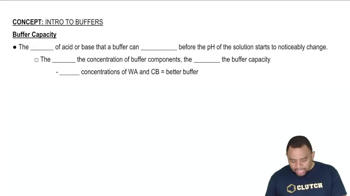Here are the essential concepts you must grasp in order to answer the question correctly.
Buffer Capacity
Buffer capacity refers to the ability of a buffer solution to resist changes in pH upon the addition of small amounts of acid or base. It is determined by the concentrations of the weak acid and its conjugate base present in the solution. A higher concentration of these components generally leads to a greater buffer capacity, allowing the solution to maintain its pH more effectively.
Recommended video:
Henderson-Hasselbalch Equation
The Henderson-Hasselbalch equation is a mathematical formula used to calculate the pH of a buffer solution. It is expressed as pH = pKa + log([A-]/[HA]), where [A-] is the concentration of the conjugate base and [HA] is the concentration of the weak acid. This equation highlights the relationship between the concentrations of the buffer components and the resulting pH, which is crucial for understanding buffer effectiveness.
Recommended video:
Henderson-Hasselbalch Equation
Concentration of Buffer Components
The concentration of buffer components, specifically the weak acid and its conjugate base, directly influences the buffer's capacity. In the given question, comparing the concentrations of NH4Br (the weak acid) and NH3 (the conjugate base) in each solution allows us to determine which buffer can better resist pH changes. Higher concentrations of these components lead to a more effective buffer system.
Recommended video:
 Verified step by step guidance
Verified step by step guidance

